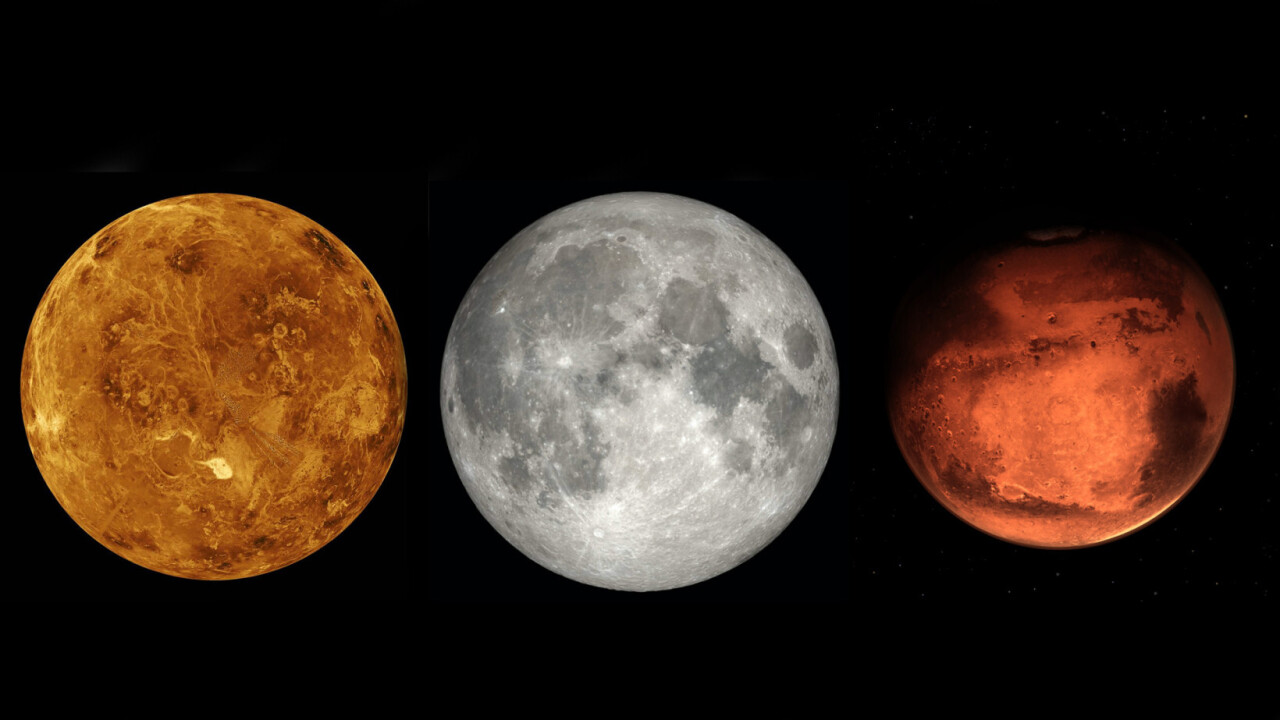Early on the evening of Monday, 12 July, a thin crescent Moon will be seen low on the horizon, just after sunset. Just half a degree below and to the right of our planetary companion, Venus and Mars — the two closest planets to Earth, will shine in the twilight.
This is a perfect time for families to venture outside, viewing the wonders of the night sky.
“I’m NOT a Star” — Venus
Venus is often called the morning star, or evening star (depending on when the planet rises and sets), due to the fact it is seen near the Sun — in the east at dawn, and west at sunset.
The evening of 12 July is a perfect example of Venus as the evening star.
This planet, roughly the size and mass of the Earth, is home to a hellish landscape of scorching temperatures, a poisonous atmosphere, and sulfuric acid rain.
“In June, NASA announced that two new space missions would be heading to Venus beginning later in the decade. VERITAS and DAVINCI+ will investigate the planet’s surface and atmosphere, returning incredible images, maps, and other data, likely rewriting our understanding of how Earth’s sister planet became so inhospitable, along with how it might still be active today. They’ll be joined by the European spacecraft EnVision, for what’s sure to be an exciting new chapter in solar system exploration,” NASA describes.
“Better Red than Dead — Eat THAT, Pluto!” — Mars

Shining bright red near the Moon and Venus, Mars completes the evening’s cosmic triangle.
Mars is now a planet of robots, as orbiters, landers, and rovers explore the Red Planet. Robotic explorers built by NASA, the ESA are now joined by intrepid robotic explorers from China and the UAE.
Mars will, almost certainly, be the first world after the Earth on which humans lead out their lives. If we are smart enough, brave enough, and far-sighted enough to overcome the anti-science paradigm perpetuated far too often on social media, Mars provides us our best chance to become a multi-planetary species.
As seen from Mars, the Earth will be an “evening star” or “morning star” to future Martian colonists.
How long will it be until people living on Mars will look to Earth, hanging out as a bright light in the Martian sky? Will they see the Martian moons — Phobos and Deimos — as they appear to huddle together with Earth?
A Neighborhood Get-Together
“Counting stars by candlelight, all are dim but one is bright;
The spiral light of Venus, rising first and shining best,
On, from the northwest corner, of a brand new crescent moon,
While crickets and cicadas sing, a rare and different tune,
Terrapin Station” — The Grateful Dead,Terrapin Station

Anyone can view this event without any special equipment — The Moon, Mars, and Venus are all easily visible using just the naked eye. This event will be seen by most people around the globe, provided the skies above them are clear.
Ideally, skygazers will want to head outside just a little after sunset, to a dark location, with a clear view to the west. This event will be visible for around 30 minutes before Mars and Venus set, so bring chairs, drinks, and snacks if you’ve got them! If you have a pair of binoculars, bring them along!
The thin two-day old Moon will be the first of the objects seen — a slender crescent will appear, staking its claim on the darkening sky. Look for the first signs of this young Moon about 20 degrees above the western horizon.
Minutes later, the shining light of Venus will make itself known, just about 3.5 degrees to the right and a little over six degrees below, the Moon.
One handy trick for observing the night sky is to hold an index finger out at arm’s length. This will cover about half a degree side-to-side, around the size of the Moon or the Sun as seen from Earth. a clenched fist held at arm’s length covers about 10 degrees from thumb to pinkie finger.
Following the arrival of Venus, a red light — first dim, then growing progressively brighter as the sky darkens, will be seen just one-sixth of a degree below and half a degree west of the Moon. This is, of course, the planet Mars.
Make sure to see Moon, Mars, and Venus together in the sky on 12 July, low on the western horizon, just after sunset.
This article was originally published on The Cosmic Companion by James Maynard, the founder and publisher of The Cosmic Companion. He is a New England native turned desert rat in Tucson, where he lives with his lovely wife, Nicole, and Max the Cat. You can read the original article here.
Get the TNW newsletter
Get the most important tech news in your inbox each week.





